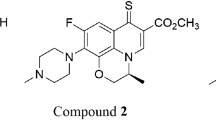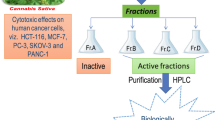Abstract
The present study reports anticancer and antioxidant activities of Callistemon lanceolatus bark extracts. Anticancer activity was studied against MDA-MB-231 cells. Antioxidant assessment of the chloroform and methanol extracts showed considerable free radical scavenging, metal ion chelating, and reducing power potential. Chloroform extract exhibited potent inhibition of cancer cell proliferation in MTT assay (IC50 9.6 μg/ml) and promoted programmed cell death. Reactive oxygen species (ROS) generation, mitochondria membrane potential (MMP) disruption ability, and nuclear morphology changes were studied using H2-DCFDA, JC-1, and Hoechst dyes, respectively, using confocal microscopy. Apoptotic cells exhibited fragmented nuclei, increased ROS generation, and altered MMP in dose- and time-dependent manner. Chloroform extract upregulated the BAX-1 and CASP3 mRNA expression coupled with downregulation of BCL-2 gene. Further, in silico docking of phytochemicals present in C. lanceolatus with anti-apoptotic Bcl-2 protein endorsed apoptosis by its inhibition and thus corroborated the experimental findings. Obatoclax, a known inhibitor of Bcl-2 was used as a reference compounds.







Similar content being viewed by others
Data availability
The data generated during the current study are available from the corresponding author on reasonable request.
References
Singh AK, Singh SV, Kumar R, Kumar S, Senapati S, Pandey AK. Current therapeutic modalities and chemopreventive role of natural products in liver cancer: Progress and promise. World J Hepatol. 2023;15(1):1–18. https://doi.org/10.4254/wjh.v15.i1.1.
Huang M, Lu JJ, Ding J. Natural products in cancer therapy: Past, present and future. Nat Prod Bioprospec. 2021;11:5–13. https://doi.org/10.1007/s13659-020-00293-7.
Ganguly R, Kumar R, Pandey AK. Baicalin provides protection against fluoxetine-induced hepatotoxicity by modulation of oxidative stress and inflammation. World J Hepatol. 2022;14:729–43. https://doi.org/10.4254/wjh.v14.i4.729.
Singh AK, Singla RK, Pandey AK. Chlorogenic acid: A dietary phenolic acid with promising pharmacotherapeutic potential. Curr Med Chem. 2022. https://doi.org/10.2174/0929867329666220816154634.
Islam MdS, Rahi MdS, Jahangir CA, Rahman MH, Jerin I, Amin R, et al. In vivo anticancer activity of Basella alba leaf and seed extracts against Ehrlich’s ascites carcinoma (EAC) cell line. Evid-Based Complement Altern Med. 2018;2018:1–11. https://doi.org/10.1155/2018/1537896.
Kushwaha PP, Kumar R, Neog PR, et al. Characterization of phytochemicals and validation of antioxidant and anticancer activity in some Indian polyherbal ayurvedic products. Vegetos. 2021;34:286–99. https://doi.org/10.1007/s42535-021-00205-1.
Siegel RL, Miller KD, Jemal A. Cancer statistics, 2020. CA Cancer J Clin. 2020;70:7–30. https://doi.org/10.3322/caac.21590.
Shin VY, Chen J, Cheuk IWY, Siu M-T, Ho C-W, Wang X, et al. Long non-coding RNA NEAT1 confers oncogenic role in triple-negative breast cancer through modulating chemoresistance and cancer stemness. Cell Death Dis. 2019;10:270. https://doi.org/10.1038/s41419-019-1513-5.
Gupta A, Singh AK, Kumar R, Jamieson S, Pandey AK, Bishayee A. Neuroprotective potential of ellagic acid: a critical review. Adv Nutr. 2021;12:1211–38. https://doi.org/10.1093/advances/nmab007.
Mitra S, Dash R. Natural products for the management and prevention of breast cancer. Evid-Based Complement Altern Med. 2018;2018:1–23. https://doi.org/10.1155/2018/8324696.
Gupta A, Shridhar K, Dhillon PK. A review of breast cancer awareness among women in India: Cancer literate or awareness deficit. Eur J Cancer. 2015;51:2058–66. https://doi.org/10.1016/j.ejca.2015.07.008.
Rakha EA, Reis-Filho JS, Ellis IO. Basal-like breast cancer: a critical review. J Clin Oncol. 2008;26:2568–81. https://doi.org/10.1200/JCO.2007.13.1748.
Kumar S, Pandey AK. Potential molecular targeted therapy for unresectable hepatocellular carcinoma. Curr Oncol. 2023;30:1363–80. https://doi.org/10.3390/curroncol30020105.
Pandey A, Kumar R, Mishra A, Pandey A, Pandey AK. Recent updates on the pharmacological potential of plant-based Rutin. Curr Nutraceut. 2022;3(2):e140622205967. https://doi.org/10.2174/2665978603666220614151613.
Prescott C, Bottle SE. Biological relevance of free radicals and nitroxides. Cell Biochem Biophys. 2017;75:227–40. https://doi.org/10.1007/s12013-016-0759-0.
Gupta A, Singh AK, Loka M, Pandey AK, Bishayee A. Ferulic acid-mediated modulation of apoptotic signaling pathways in cancer. Adv Protein Chem Struct Biol. 2021;125:215–57. https://doi.org/10.1016/bs.apcsb.2020.12.005.
Kumar R, Singh AK, Gupta A, Bishayee A, Pandey AK. Therapeutic potential of Aloe vera—A miracle gift of nature. Phytomed. 2019;60:152996. https://doi.org/10.1016/j.phymed.2019.152996.
Albensi BC. What is nuclear factor kappa B (NF-κB) doing in and to the mitochondrion. Front Cell Dev Biol. 2019;7:154. https://doi.org/10.3389/fcell.2019.00154.
Lang F, Stournaras C. Ion channels in cancer: Future perspectives and clinical potential. Phil Trans R Soc B. 2014;369:20130108. https://doi.org/10.1098/rstb.2013.0108.
Yang M, Brackenbury WJ. Membrane potential and cancer progression. Front Physiol. 2013. https://doi.org/10.3389/fphys.2013.00185.
Pinton P, Giorgi C, Siviero R, Zecchini E, Rizzuto R. Calcium and apoptosis: ER-mitochondria Ca2+ transfer in the control of apoptosis. Oncogene. 2008;27:6407–18. https://doi.org/10.1038/onc.2008.308.
Naoi M, Wu Y, Shamoto-Nagai M, Maruyama W. Mitochondria in neuroprotection by phytochemicals: Bioactive polyphenols modulate mitochondrial apoptosis system, function and structure. Int J Mol Sci. 2019;20:2451. https://doi.org/10.3390/ijms20102451.
Ahmad K, Hafeez ZB, Bhat AR, Rizvi MA, Thakur SC, Azam A, et al. Antioxidant and apoptotic effects of Callistemon lanceolatus leaves and their compounds against human cancer cells. Biomed Pharmacother. 2018;106:1195–209. https://doi.org/10.1016/j.biopha.2018.07.016.
Kumar R, Gupta A, Singh AK, Bishayee A, Pandey AK. The Antioxidant and antihyperglycemic activities of bottlebrush plant (Callistemon lanceolatus) stem extracts. Medicines. 2020;7:11.
Salem MZM, El-Hefny M, Nasser RA, Ali HM, El-Shanhorey NA, Elansary HO. Medicinal and biological values of Callistemon viminalis extracts: History, current situation and prospects. Asian Pacific J Trop Med. 2017;10:229–37.
Mishra AK, Mishra A, Kehri H, Sharma B, Pandey AK. Inhibitory activity of Indian spice plant Cinnamomum zeylanicum extracts against Alternaria solani and Curvularia lunata, the pathogenic dematiaceous moulds. Ann Clin Microbiol Antimicrob. 2009;8:9. https://doi.org/10.1186/1476-0711-8-9.
Chang CC, Yang MH, Wen HM, Chern JC. Estimation of total flavonoid content in propolis by two complementary colometric methods. J Food Drug Anal. 2020. https://doi.org/10.38212/2224-6614.2748.
Singh RP, Chidambara Murthy KN, Jayaprakasha GK. Studies on the antioxidant activity of pomegranate (Punica granatum) peel and seed extracts using in vitro models. J Agric Food Chem. 2002;50:81–6. https://doi.org/10.1021/jf010865b.
Oyaizu M. Studies on products of browning reaction: antioxidative activities of products of browning reaction prepared from glucosamine. Jpn J Nutr Diet. 1986;44:307–15. https://doi.org/10.5264/eiyogakuzashi.44.307.
Dinis TCP, Madeira VMC, Almeida LM. Action of phenolic derivatives (acetaminophen, salicylate, and 5-aminosalicylate) as inhibitors of membrane lipid peroxidation and as peroxyl radical scavengers. Arch Biochem Biophys. 1994;315:161–9. https://doi.org/10.1006/abbi.1994.1485.
Negi PS, Jayaprakasha GK. Control of foodborne pathogenic and spoilage bacteria by garcinol and Garcinia indica extracts, and their antioxidant activity. J Food Sci. 2006;69:FMS61–5.
Mosmann T. Rapid colorimetric assay for cellular growth and survival: Application to proliferation and cytotoxicity assays. J Immunol Meth. 1983;65:55–63. https://doi.org/10.1016/0022-1759(83)90303-4.
Mechoulam H, Pierce EA. Expression and activation of STAT3 in ischemia-induced retinopathy. Invest Ophthalmol Vis Sci. 2005;46:4409. https://doi.org/10.1167/iovs.05-0632.
He X, Sun J, Huang X. Expression of caspase-3, Bax and Bcl-2 in hippocampus of rats with diabetes and subarachnoid hemorrhage. Exp Ther Med. 2017. https://doi.org/10.3892/etm.2017.5438.
Scoumanne A, Cho SJ, Zhang J, Chen X. The cyclin-dependent kinase inhibitor p21 is regulated by RNA-binding protein PCBP4 via mRNA stability. Nucleic Acids Res. 2011;39:213–24. https://doi.org/10.1093/nar/gkq778.
Souers AJ, Leverson JD, Boghaert ER, Ackler SL, Catron ND, Chen J, et al. ABT-199, a potent and selective BCL-2 inhibitor, achieves antitumor activity while sparing platelets. Nat Med. 2013;19:202–8.
Rana N, Singh AK, Shuaib M, Gupta S, Habiballah MM, Alkhanani MF, et al. Drug Resistance mechanism of M46I-mutation-induced Saquinavir resistance in HIV-1 protease using molecular dynamics simulation and binding energy calculation. Viruses. 2022;14:697. https://doi.org/10.3390/v14040697.
Daina A, Michielin O, Zoete V. SwissADME: A free web tool to evaluate pharmacokinetics, drug-likeness and medicinal chemistry friendliness of small molecules. Sci Rep. 2017;7:42717. https://doi.org/10.1038/srep42717.
Kushwaha PP, Singh AK, Prajapati KS, Shuaib M, Gupta S, Kumar S. Phytochemicals present in Indian ginseng possess potential to inhibit SARS-CoV-2 virulence: A molecular docking and MD simulation study. Microb Pathog. 2021;157:104954. https://doi.org/10.1016/j.micpath.2021.104954.
Dizdaroglu M, Jaruga P, Birincioglu M, Rodriguez H. Free radical-induced damage to DNA: Mechanisms and measurement. Free Rad Biol Med. 2002;32:1102–15. https://doi.org/10.1016/s0891-5849(02)00826-2.
Kushwaha PP, Singh AK, Shuaib M, Prajapati KS, Vardhan PS, Gupta S, et al. 3-O-(E)-p-Coumaroylbetulinic acid possess anticancer activity and inhibit Notch signaling pathway in breast cancer cells and mammosphere. Chem-Biol Int. 2020;328:109200. https://doi.org/10.1016/j.cbi.2020.109200.
Uchiyama T, Tabata K, Nomura S, Kaneko Y, Fujimoto Y, Suzuki T. Induction of apoptosis in human leukemia cell (Jurkat) by neolignans isolated from seeds of licariapuchury-major. Biol Pharmaceut Bull. 2009;32:1749–53. https://doi.org/10.1248/bpb.32.1749.
Rahman MDA, Hannan MDA, Dash R, Rahman MDH, Islam R, Uddin MJ, et al. Phytochemicals as a complement to cancer chemotherapy: Pharmacological modulation of the autophagy-apoptosis pathway. Front Pharmacol. 2021;12:639628. https://doi.org/10.3389/fphar.2021.639628.
Rezaei PF, Fouladdel S, Hassani S, Yousefbeyk F, Ghaffari SM, Amin G, et al. Induction of apoptosis and cell cycle arrest by pericarp polyphenol-rich extract of Baneh in human colon carcinoma HT29 cells. Food Chem Toxicol. 2012;50:1054–9. https://doi.org/10.1016/j.fct.2011.11.012.
Acknowledgements
RK acknowledges financial support from Council of Scientific and Industrial Research (CSIR), New Delhi in the form of Senior Research Fellowship and Indian Council of Medical Research (ICMR), New Delhi for Research Associate fellowship (File No. 3/2/3/65/2022/NCD-III). In vitro studies described in the current article are part of a PhD thesis of RK. PPK and AKS acknowledge ICMR and CSIR for financial support in the form of Senior Research Fellowships, respectively. RK and AKP also acknowledge UGC-SAP and DST-FIST facilities of Biochemistry Department, University of Allahabad, Prayagraj, India.
Funding
No specific funding was received for this study.
Author information
Authors and Affiliations
Contributions
AKP and SK conceptualized the idea. RK performed antioxidant experiments. RK, PPK, and AKS performed anticancer and in silico experiments. RK, SK, and AKP analyzed the data. RK wrote the first draft of the manuscript. AKP and SK critically reviewed and revised the manuscript. All authors have read and approved the final manuscript.
Corresponding author
Ethics declarations
Conflict of interest
None.
Additional information
Publisher's Note
Springer Nature remains neutral with regard to jurisdictional claims in published maps and institutional affiliations.
Supplementary Information
Below is the link to the electronic supplementary material.
Rights and permissions
Springer Nature or its licensor (e.g. a society or other partner) holds exclusive rights to this article under a publishing agreement with the author(s) or other rightsholder(s); author self-archiving of the accepted manuscript version of this article is solely governed by the terms of such publishing agreement and applicable law.
About this article
Cite this article
Kumar, R., Kushwaha, P., Singh, A.K. et al. Anti-proliferative, apoptosis inducing, and antioxidant potential of Callistemon lanceolatus bark extracts: an in vitro and in silico study. Med Oncol 40, 169 (2023). https://doi.org/10.1007/s12032-023-02035-4
Received:
Accepted:
Published:
DOI: https://doi.org/10.1007/s12032-023-02035-4




